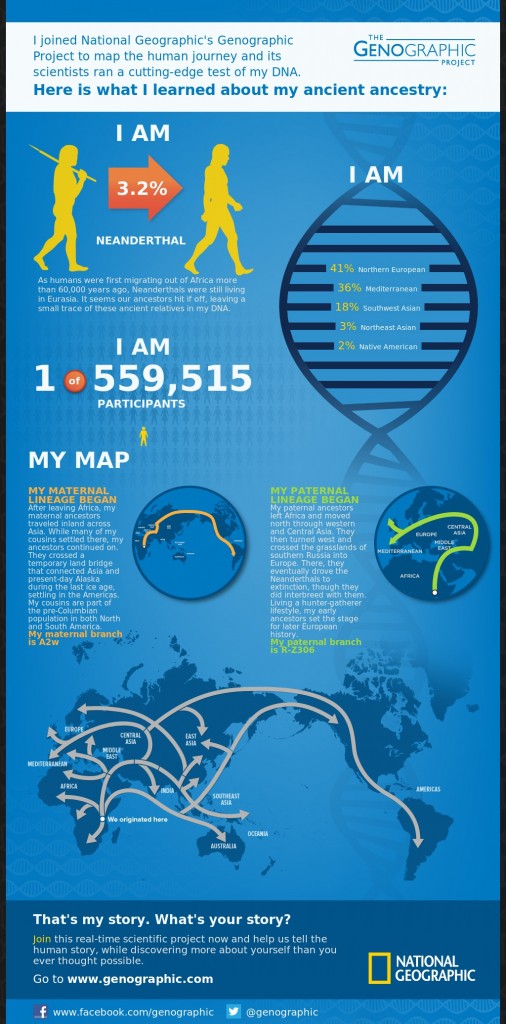I received my results from the Geno 2.0 test from National Genographic tonight. The results align fairly well with what I already know about my DNA. For example, I knew I was haplogroup A2 (a Native American haplogroup), but the A2w is new so I have to do some research there.
Even more interesting is my paternal haplogroup designation. The NatGeo tests lists the terminal SNP instead of a haplogroup that will typically encompass multiple SNPs. I am listed as R-Z306, which is R1b1a2a1a1a3a1 on the current ISOGG Y-DNA tree. However, my results indicate that I am L1+, which is associated with Null439 (I previously knew I was null439). Many believe that L1+ is downstream of Z306+, but these types of questions are exactly what the NatGeo 2.0 test will help determine.
I immediately transferred my results to FTDNA, and if you go to the public null439 Y-SNP results page (here), for example, you’ll see that under my results are listed all SNPs for which I am derived, including L1, Z306, etc. It’s truly an incredible list, and the real power of the results will come from comparing them to many other people.
As you can see, NatGeo estimates 3.2% Neanderthal (23andMe predicted 2.7%), and 3.3% Denisovan. I’m not completely up on my Denisovan research, but I wonder if I am enriched for Denisovan because of my Native American ancestry.
Lastly, the NatGeo results report 2% Native American, directly in line with other tests. 23andMe, for example, has consistently reported 2-3%.
Disclosure: I received a complementary test kit from National Genographic for analysis purposes. My analysis, however, is based on my own opinions of the product and the results.

Interesting! 🙂
For the percentage breakdowns (European, Mediterranean, Asian, Native American), did you receive more specific information about it? Like for instance, exactly what type of European are you? Or, specifically where in each country your ancestors were, rather than just show arrows? The results kinda seem generic, so, I was wondering if there is a more in-depth explanation for all.
Wow, these results are really interesting. I looked at ordering the Nat Geo test, but went for the Ancestry DNA test instead because I had a fairly well documented tree on Ancestry already and I wanted to use the results to help fill in the holes in my tree rather than see where my genes came from thousands of years ago. Still, I think your results are really interesting, and I still might order this test at a later date. Great blog by the way.
Very Interesting! How long did NatGeo take to return your results?
NatGeo received my test the last week of November, and my results have not posted as of today. The test is still at 60% complete – it has been at 60% for three and a half weeks! I wonder if this is unusual. I am interested in comparing these results with the results from my Ancestry.com test. We sill see.
Do I need to have an existing MyFTDNA account or – in other words-do I need to had prior tests done by family tree dna to be able to upload the data on the myftdna site?
I am repeating this question the first commenter asked since I have the exact same inquiry:
“For the percentage breakdowns (European, Mediterranean, Asian, Native American), did you receive more specific information about it? Like for instance, exactly what type of European are you? Or, specifically where in each country your ancestors were, rather than just show arrows? The results kinda seem generic, so, I was wondering if there is a more in-depth explanation for all.” -A
Please answer this question. Thanks
I took many DNA tests since I never knew who or what I was Never met a
Relative beyond maternal 9 months DNA Tribes told me what I was
23and me and FTDNA and iGnea told me all about the Rooneys my adoptive
surname and ZERO to do with me ethnically